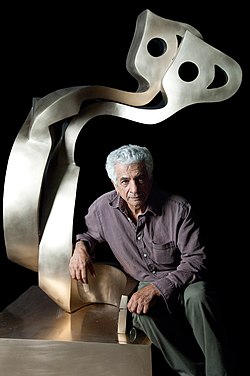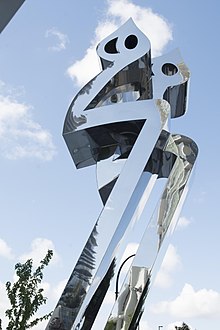Parviz Tanavoli
Parviz Tanavoli (born 24 March 1937 in Tehran) is an Iranian sculptor, painter, scholar and art collector. Since 1989 he has lived and worked both in Tehran and Vancouver, Canada.
Parviz Tanavoli | |
|---|---|
 | |
| Born | Parviz Tanavoli 24 March 1937 |
| Nationality | Iranian Canadian |
| Education | Tehran School of Fine Arts Brera Academy |
| Known for | Sculpture and Painting |
Notable work | The Wall (Oh Persepolis) Heech |
| Movement | Saqqakhaneh movement Huryfiyya movement |
| Patron(s) | Farah Pahlavi Abby Weed Grey |
Tanavoli's work has been auctioned around the world leading to overall sales of over $9 million, making him the most expensive living Iranian artist.[1] His Wall “Oh Persepolis” fetched $2.84 million at a Dubai Christie’s sale, in 2008, an auction record for a Middle Easton artist.* Tanavoli is known for his heeches, three dimensional representations of the Persian word for 'nothing', heech. Composed of three Persian characters in the style of nasta'liq, the three letters he, ye and če are combined to produce the word ‘heech’. [2]
His heeches are displayed in prestigious museums and public places such as British Museum, Metropolitan Museum, Hamline University, St. Paul Minnesota, Aga Khan Museum, Toronto and in the city of Vancouver.
Upon graduating from the Brera Academy of Milan in 1959, 1960 returned to Iran and taught sculpting at the Tehran College of Decorative Arts. 1961, Tanavoli taught sculpture for three years at the Minneapolis College of Art and Design. He then returned to Iran and assumed the directorship of the sculpture department at the University of Tehran, a position he held for 18 years until 1979, when he retired from his teaching duties.
Exhibitions
His latest solo exhibition was in 2019 at the West Vancouver Art Museum entitled "Oh Nightingale". Prior to that, he had another solo exhibition in 2017 at the Tehran Museum of Contemporary Art based on his Lions works and Lion collection.
In 2015, after four decades, Davis Museum at Wellesley College organized the first solo exhibition of Tanavoli's work in the US.
In 2003 he had a major retrospective at the Tehran Museum of Contemporary Art. Prior to that he had held solo exhibitions in Austria, Italy, Germany, United States and Britain. Tanavoli has been in group exhibitions internationally.
His work has been displayed at the Tate Modern, British Museum, Metropolitan Museum of Art, the Grey Art Gallery - New York University, the Isfahan City Center, Nelson Rockefeller Collection, New York, Olympic Park, Seoul, South Korea, the Royal Museum of Jordan, the Museum of Modern Art, Vienna, Museum of Modern Art, New York, Walker Art Center, Minneapolis, Hamline University, St. Paul[3] and Shiraz University, Iran.[4]
.jpg)

Influences
He belongs to the Saqqakhana group of artists who, according to the scholar Karim Emami, share a common popular aesthetic.[5] He has been influenced heavily by his country's history and culture and traditions (he was once cultural advisor to the Queen of Iran), and has always been fascinated with locksmithing.
Politics and art
In 2005, he created a small piece of sculpture called Heech in a Cage to protest the conditions of the American-held prisoners at Guantanamo Bay detainment camp and in 2006 began work on his piece to honour the victims of the Israeli-Lebanon war. A day before Tanavoli was due to speak at the British Museum, authorities in Iran confiscated his passport, preventing him from leaving the country, accusing him of “Disturbing the public peace”. Tanavoli explained that "I have not done anything wrong. I spent the whole day at the passport office but no one told me anything, nor did anyone at the airport. I’m not a political person, I’m merely an artist."[6]
Portrayal in film
The documentary film "Parviz Tanavoli: Poetry in Bronze",[7] released in 2015 tells the remarkable story of Tanavoli's journey of creation that began in Iran in the 1950s and has spanned three continents over more than half a century. Directed by Terrence Turner and produced by Timothy Turner and Tandis Tanavoli, the documentary features exclusive interviews with Tanavoli and leading figures in the international art world who illuminate the emergence and rise of this extraordinary artist who continues to this day to return to Iran from his adopted home in Canada to teach young, aspiring artists.
Bibliography
Books by Tanavoli
Tanavoli has authored over forty publications, dating back over four decades. Among these are:
- Parviz Tanavoli and the Lions of Iran. Tehran: Nazar Publishing. 2017. ISBN 9786001522413.
- Lovers. Tehran: Bongah. 2017.
- Khorjins - Tribal And Rural Weaves From Iran (2). Tehran: Nazar Publishing. 2017. ISBN 978-6001522239.
- European women in Persian houses: Western images in Safavid and Qajar Iran. 2015. ISBN 978-1-78453-507-0.
- Salt Bags - Tribal and Rural Weaves from Iran. 2015.
- An Introduction To The History Of Graphic Design In Iran. 2015.
- Poet. Tehran: Bongah. 2014.
- Wonders of Universe. Tehran: Bongah. 2012.
- Rugs. Tehran: Bongah. 2011.
- Heech. Tehran: Bongah. 2011.
- Undiscovered Minimalism: Gelims from Northern Iran. 2011. ISBN 978-1-898113-76-8.
- Afshar; Tribal Weaves from Southern Iran. Tehran: Iranian Academy of Arts. 2010.
- Ceramics. Tehran: Bongah. 2010.
- Tomb Stone. Tehran: Bongah. 2009.
- Jewelry by Parviz Tanavoli. 2008.
- Scales and Weights. 2007.
- Talisman. 2006.
- Sormehdan Kohl Containers of Iran. 2006.
- Atelier Kaboud. 2005.
- Gabbeh: Art Underfoot. Tehran: Yassavoli Publications. 2004.
- Tribal and Rustic Weaves from Varamin. 2003.
- Persian Flatweaves. London: Antique Collectors' Club. 2002. ISBN 978-1-85149-335-7.
- Rustic & Tribal Weaves from Varamin. 2001.
- Persian Steel The Tanavoli Collection. 2001.
- The Tacheh Of Chahar Mahal. 1998.
- Horse and Camel Trappings from Tribal Iran. 1998.
- Sofreh of Kamo. Tehran. 1996.
- Kings, Heroes and Lovers: Pictorial Rugs from the Tribes and Villages of Iran. London: Scorpion Pub. 1994. ISBN 978-0-905906-86-7.
- Bread and Salt; Iranian Tribal Spreads and Salt Bags. 1991.
- Gabbeh. Baar, Switzerland. 1990.
- Shahsavan: Iranian Rugs and Textiles. New York. 1985.
- Lion Rugs; The Lion in the Art and Culture of Iran. Basel. 1985.
- Locks from Iran; Pre-Islamic to Twentieth Century. Washington DC. 1976.
Books on Tanavoli
Books, catalogs, and magazines on Parviz Tanavoli
- Tanavoli, Parviz; Fischman, Lisa; Balaghi, Shiva; Amirsadeghi, Hossein; Eisler, Maryam Homayoun; Davis Museum and Cultural Center (2015). Parviz Tanavoli. ISBN 978-0-9858249-3-8.
- Tanavoli, Parviz (2011). Parviz Tanavoli: Poet in Love : 1970s-2011 works from the artist's collection. London: Austin/Desmond Fine Art. ISBN 978-1-872926-35-3.
- Tanavoli, Parviz; Pocock, Charles; Faruqi, Samar (2010). Parviz Tanavoli: monograph. Dubai, United Arab Emirates: Publications Department of Meem with Art Advisory Associates Ltd. ISBN 978-1-907051-03-6.
- Tanavoli, Parviz; Universität Zürich; Völkerkundemuseum; Musée des arts décoratifs de la ville de Lausanne (1985). Lion rugs: the lion in the art and culture of Iran. Basel: publisher not identified] ; Distributed in the USA by Transbooks. ISBN 978-3-85977-078-2.
- Tanavoli, Parviz; Grey Art Gallery & Study Center (1976). Parviz Tanavoli: fifteen years of bronze sculpture. New York: Grey Art Gallery and Study Center, New York University.
References
- http://www.artomorrow.com/eng/index.asp?page=49&id=206
- "Standing heech". National Museums Scotland. Archived from the original on 4 February 2017. Retrieved 3 February 2017.
- http://www.hamline.edu/about/virtual-tour/heech.html
- Harouni, Shadi (10 February 2015). "Parviz Tanavoli: plenty of 'nothing' - exhibition". The Guardian. Retrieved 3 February 2017.
- Ekhtiar, Maryam; Rooney, Julia (April 2014). "Artists of the Saqqakhana Movement (1950s–60s)". Heilbrunn Timeline of Art History. Metropolitan Museum of Art. metmuseum.org. Retrieved 2017-02-04.
- theguardian.com July 2, 2016
- Poetry In Bronze
External links
- "Tanavoli.com"
- Parviz Tanavoli: Poetry in Bronze on IMDb
- "Poetry in Bronze"
- Mohammed Afkhami, Sussan Babaie, Venetia Porter, Natasha Morris. "Honar: The Afkhami Collection of Modern and Contemporary Iranian Art." Phaidon Press, 2017. ISBN 978-0-7148-7352-7.